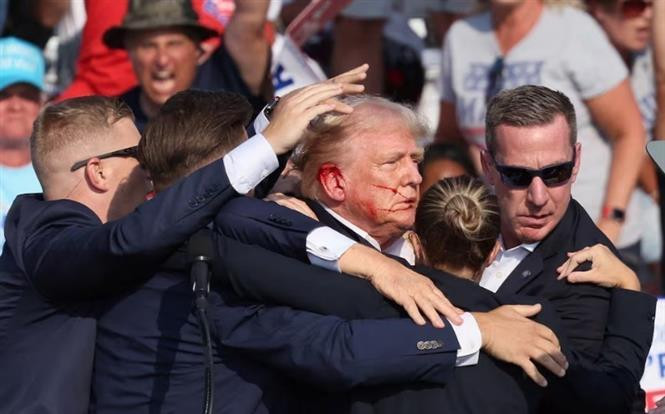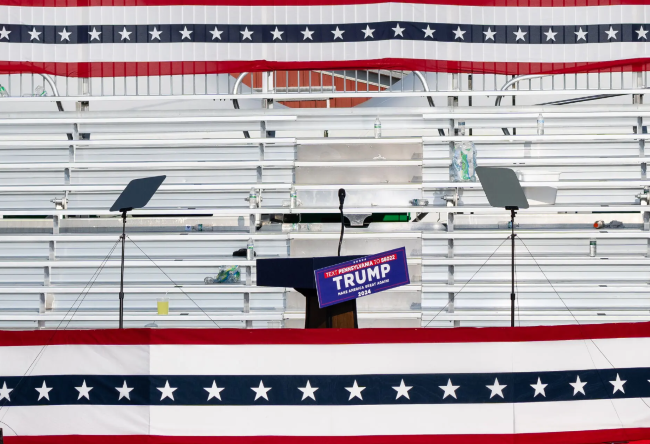The FBI director said Donald Trump may have been hit by a piece of debris in his ear, not a bullet, in the July 13 assassination attempt.

According to the New York Times, the US Federal Bureau of Investigation is assessing the cause of the ear injury to former President Trump in the attempted assassination in Butler, Pennsylvania on July 13 (local time).
The FBI is examining multiple pieces of metal found near the stage at the Butler rally to determine whether the assassin's bullet, fragments of it or something else grazed former President Donald Trump's head, causing him to bleed from his ear.
The FBI has requested an interview with Mr. Trump as part of a broader investigation, hoping to gain more details about the shooting and possibly a more complete record of his injuries, according to an official who spoke on condition of anonymity to discuss the ongoing investigation.
Bullet, piece of metal or something else?
Unanswered questions about the object that injured the Republican presidential nominee's ear have emerged since the July 13 shooting, with Mr Trump claiming he was shot and calling his survival a miracle.
FBI officials, however, have been more cautious, citing the need to analyze evidence before determining what struck Mr Trump — a bullet, a piece of metal or something else.
The FBI’s shooting reconstruction team “continues to examine evidence from the scene, including bullet fragments, and the investigation remains ongoing,” the FBI said in a statement on July 25. In addition to wounding Trump, the gunman, Thomas Crooks, 20, of Bethel Park, Pennsylvania, also shot three people at the rally, killing one.

Steven Cheung, a spokesman for Mr Trump's campaign, would not say whether the FBI had requested to review the former president's medical records following the incident, but he himself has not yet released them.
A political issue
The FBI considers identifying the object that grazed former President Trump’s ear important but not central to its broader criminal investigation into the gunman’s actions and motives. They are most interested in Crooks’ motives or any indication that he may have had accomplices or help. So far, authorities have not found a motive for Crooks’s actions or a mastermind behind them.
“The FBI’s priority is to find out if anyone assisted the shooter and eliminate any potential threats that may exist,” said former FBI agent Michael Harrigan, who ran the agency’s firearms training unit at Quantico.
“From an investigative standpoint, it’s not really important to know what happened to the president’s ear,” Mr. Harrigan added.
However, this is important from a political perspective.
“With respect to former President Trump, there are some questions about whether a bullet or fragments hit his ear,” FBI Director Christopher A. Wray told Republican Rep. Jim Jordan, who is chairman of the House Judiciary Committee, on July 24.
The statement sparked a backlash and Republicans continued to attack Mr Wray.
“It’s shocking that Christopher Wray doesn’t know what the truth is, but that probably says more about his job performance — or lack thereof — than anything else,” said former President Trump campaign spokesman Steven Cheung.
Meanwhile, House Speaker Mike Johnson told NBC on July 25: “We have all seen the video, we have seen the analysis, we have heard from multiple sources from different angles that a bullet went through his ear.”
“There is a lot of frustration and concern about the leadership of these agencies,” Mr. Johnson added.
In a social media post on the evening of July 25 (local time), Mr. Trump also criticized Mr. Wray, saying: "No wonder the FBI has lost the confidence of America!"
The former president said there were no pieces of glass or bullet fragments. “No, unfortunately, a bullet hit my ear and hit it very hard,” he said.
In a statement, the FBI asserted “consistently and clearly that the shooting was an attempt to assassinate former President Trump, injuring him, as well as causing casualties to three others.”
Bullets are very fragile on impact.
It is not unusual for the type of bullet Crooks fired from his AR-15-style semiautomatic rifle to fragment after hitting even a small solid object. Gun experts said a fragment could, for example, bounce off a metal pole.
However, a bullet could have grazed Mr Trump's ear, and the FBI has not ruled that out. Investigators found eight shell casings on the roof of the home where the shooter was located.
It’s unclear whether investigators have ruled out other potential sources of debris. But FBI analysts appear to be focusing on metal fragments, rather than glass, from the teleprompter on stage, which remained intact after the shooting.
They are also examining still images and other electronic evidence for clues.
Gun experts say the FBI could rely on trajectory analysis, physical examination of any bullets involved, and the president’s wounds to figure out what happened. The agency could also benefit if the former president’s DNA is found on a piece of bullet fragment.
Another scenario investigators are likely to explore: that the deadly but fragile bullet may have fragmented after grazing Mr. Trump’s ear.
“The problem you have with a bullet traveling 3,200 feet per second is that it’s very susceptible to shattering when it hits a surface in front of the target,” Harrigan said.